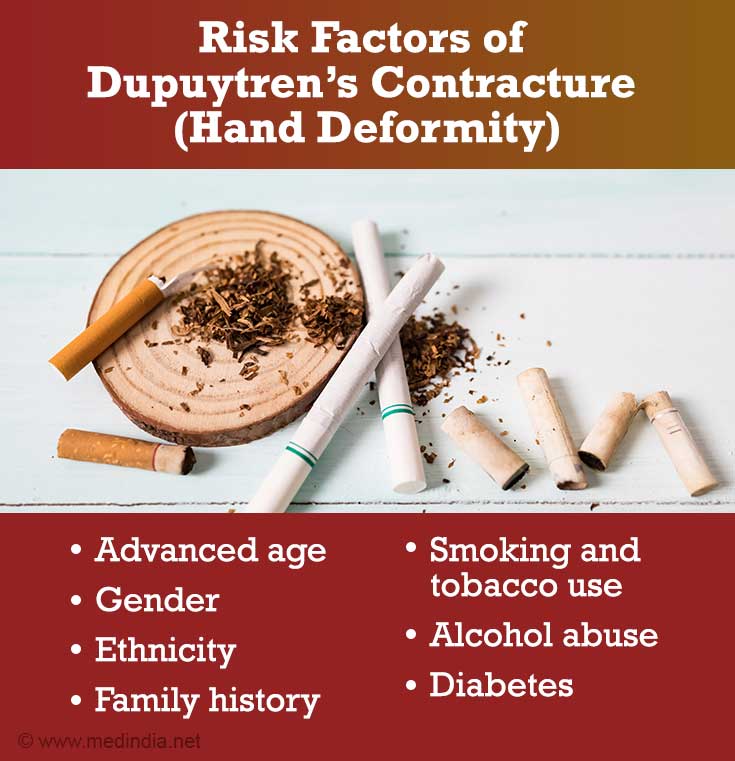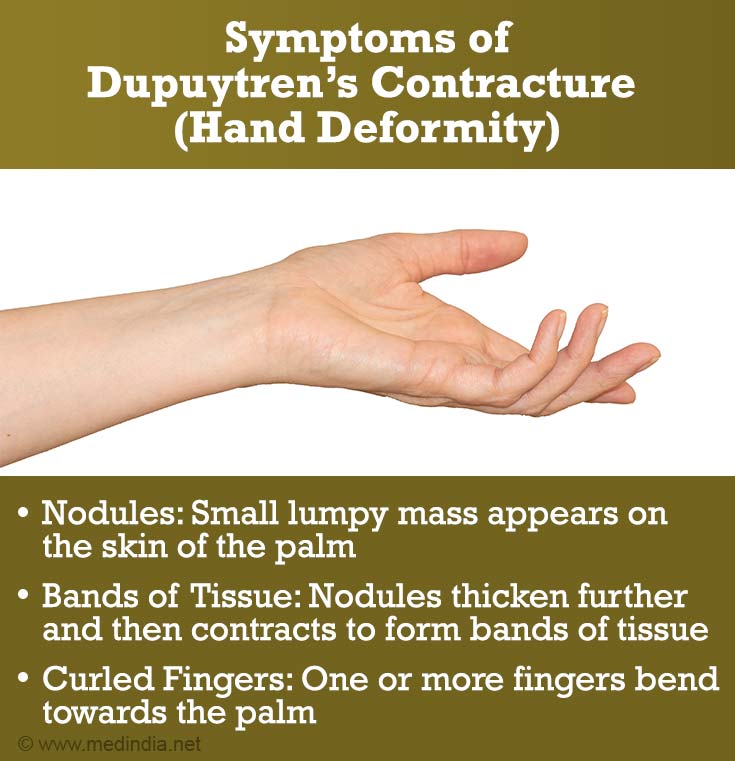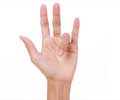- Egton Medical Information (2015) Dupuytren’s contracture. - (http://patient.info/health/dupuytrens-contracture-leaflet)
- American Association of Orthopaedic Surgeons (2014) Dupuytren’s contracture. - (http://orthoinfo.aaos.org/topic.cfm?topic=a00008)
- Mayo clinic (2014) Dupuytren’s contracture. - ( http://www.mayoclinic.org/diseases-conditions/dupuytrens-contracture/basics/definition/con-20024378)
What is Dupuytren’s Contracture / Viking’s Disease?
Dupuytren’s contracture is a medical condition affecting the hands and fingers. It is also known as Morbus Dupuytren and in slang terms "Viking disease" or "Celtic hand.” Dupuytren’s contracture is characterized by thickening of tissues in the palm. If the condition progresses, it affects one or more fingers in the palm and bends them towards the palm, and the fingers cannot be straightened fully. The condition mostly affects the ring finger followed by the little finger and then the middle finger. It progresses very slowly and takes months to years to develop a severe contracture. Usually both the hands are affected simultaneously.
While the condition is usually not painful, it may affect the daily activities of the patient. Bent fingers hamper normal activities like buttoning the shirt, taking out mobile from the pocket, handling spoons and forks, and so on.
It has been observed that many patients with Dupuytren’s contracture also have tissue thickening in other parts of their body like on the knuckle, soles of feet, or on the penis.
What Causes Dupuytren’s Contracture / Viking’s Disease?
Thickening of the connective tissues in the palm causes Dupuytren’s contracture. These connective tissues are present between the skin and the tendons of the palm. The connective tissue develops bands, which pull the fingers towards the palm.
Factors which cause such abnormal thickening of connective tissues in the palm are unknown. However, as the condition runs in the family, it is considered that genetic factors are the main cause. It is more common in people originating from North Europe. Many researchers believe that trauma or injury to palm can also lead to abnormal thickening of connective tissues. No relation between factors like the type of job, using vibrating tools, or intensive manual work, and development of Dupuytren’s contracture has been found so far.
What are the Risk Factors of Dupuytren’s Contracture / Viking’s Disease?
While no specific causative factors for Dupuytren’s contracture are known, a number of factors are believed to increase the risk for the condition. The risk factors are as below:
- Advanced age: The disease is more common after 50 years of age.
- Gender: The disease is more common in men than in women. Also, men are found to have more severe contracture of fingers than women.
- Ethnicity: The condition is widely observed in residents of north Europe.
- Family history: Presence of the disease in first-degree relatives like parents or siblings increases the risk for the disease.
- Smoking and tobacco use: Research suggests that harmful chemicals in tobacco cause microscopic changes in the blood vessels of connective tissues and thus lead to abnormal thickening which causes Dupuytren’s contracture.

- Alcohol abuse: It is believed that alcohol abuse also affects the connective tissue in the similar manner to tobacco. Chronic alcoholics are at high risk of developing the disease.
- Diabetes: Reports suggest that moderate-to-poorly controlled diabetes can increase the risk of the disease.
What are the Symptoms and Signs of Dupuytren’s Contracture / Viking’s Disease?
The symptoms of Dupuytren’s contracture appear gradually and in stages. The different presentations of the disease are as below:
- Nodules: Small lumpy mass appears on the skin of the palm. Initially, these lumps are tender to touch, but the tenderness goes away with disease progression.
- Bands of tissues/ Cord: The nodules thicken further and then contract to form bands of tissue, which are called cords. These tough bands are present below the skin and can be observed as thick and elevated linings.
- Curled fingers: One or more finger bends towards the palm. With time, it becomes more and more difficult to straighten the fingers. The disease affects ring finger first, followed by the little finger and then middle finger. In rare conditions, it can affect all the fingers including the thumb.

How to Diagnose Dupuytren’s Contracture / Viking’s Disease?
Dupuytren’s disease is usually diagnosed by physical examination only and do not require any extensive laboratory testing or diagnostic evaluation. The physician observes the hand of patient and compares it with the other hand. During the process, he/she tries to identify any abnormal wrinkling of the skin of the palm. By pressing the palm in different areas, he/she identifies tough knots or bands, if present. Curled fingers are readily observed by the physician. Blood tests may be required to detect underlying conditions like diabetes.
What are the Treatment and Medications for Dupuytren’s Contracture?
Treatment approaches for Dupuytren’s disease are considered as per the severity of the condition. The treatment options may vary from medication, radiation, or surgery.
Medical Treatment of Dupuytren’s Contracture
Usually the condition is painless and the patient does not require any analgesics or painkillers. Over-the-counter analgesic drugs like paracetamol can be used to treat occasional pain due to the condition.
In the year 2010, the US FDA approved an enzyme for the treatment of Dupuytren’s contracture. The enzyme collagenase Clostridium histolyticum is injected to the affected areas in the palm. The enzyme dissolves the connective tissue bands and relieves their pull on the fingers, thus reducing the contracture. Multiple injections in multiple sittings are required for the treatment. A recent study found that enzyme injections can reduce contracture and improve finger motion by 43.9° to 80.7° in 64% of patients.
The steroid triamcinolone could be used to treat early stages of the disease when nodules or cords are present while finger curling is absent. Within a month, five injections of the drug are injected in the affected areas on the palm and the process is repeated for six months. The steroidal drug reduces inflammation at the site and reduces the toughness of the collagen bands. Multiple injections are required to prevent progression of the disease. However, many doctors do not prefer steroid injections for Dupuytren’s contracture.

Radiotherapy
Radiotherapy for correction of Dupuytren’s contracture is applied in the early stages of the disease when no significant tough cords or finger bending is present. In multiple sittings, the affected area is exposed to low-dose X-rays. X-rays are observed to soften the tough nodules and thus retards the progression of the disease. Adverse effects observed with radiation therapy are dry skin, and itchiness. So far no cases of cancer development due to radiation therapy for Dupuytren’s contracture have been observed.
Surgical Treatment for Dupuytren’s Contracture
Surgical treatment to straighten the curved fingers is selected for the patient in below conditions:
- If the fingers are curved by 30-40° or more at the joint attaching finger to the palm (metacarpophalangeal joint).
- If the fingers are curved by 10-20° or more at any of the two upper small joints in the finger.
There are Three Main Types of Surgical Procedures:
- Open Fasciotomy: Fasciotomy literally means ‘cutting thick tissue.’ The skin above and around the nodules or/and cords is cut to expose the toughened tissue. The tough tissue is then cut and skin is then sealed back. This is a minor procedure and be done on outpatient basis under local anesthesia.
- Needle Fasciotomy: The procedure is also known as needle aponeurotomy or closed fasciotomy. The procedure is named as ‘closed’ because the surgeon need not cut the overlying skin for cutting the thickened tissue. Rather, a hypodermic needle is inserted into the skin above the contracture and then needle is moved into the tissue to disrupt and cut it. This is a minor procedure and be done on outpatient basis under local anesthesia.
While this is a quick and easy procedure without extensive invasion, it has got its own drawbacks such as:
- The procedure can only be performed if the nodule or cord is not surrounding any important nerves.
- The procedure cannot be applied for severe contractures of more than 40 degrees.
- Reports suggest that there are high chances of contracture recurrence following this procedure. Usually, the recurrence happens after 3-5 years of the procedure.
- Since the skin is not opened, there are high chances of damage to nerves, blood vessels or tendons during this procedure, which can lead to long-term complications.
- Open Fasciectomy: This is the most common surgical procedure for Dupuytren’s contracture. The method provides long-term cure and is observed to produce lesser disease recurrence as compared to the other treatment procedures.
In this extensive surgery, the skin overlying the nodules and cords as well as the site of contracture is cut opened. The thickened tissue is then cut and completely removed from the site.
It should be noted that any type of surgical procedure poses a risk of infection and minor injuries to nearby tissues. The doctors may prescribe oral antibiotics and analgesics after the surgery to prevent infection and reduce pain and inflammation at the operated site.
Health Tips
- Observe any changes in your palm and report to a doctor, especially of your parents or siblings have Dupuytren’s contracture.
- Control your diabetes.
- Stop smoking.
- Reduce alcohol intake.
- Make it a habit to apply moisturiser to your palm every day after bath.
- Apply a warm pack to the affected hand and massage it gently.






